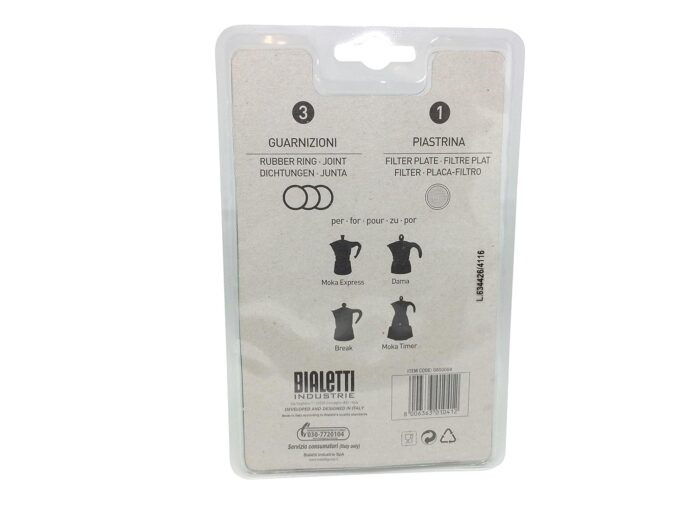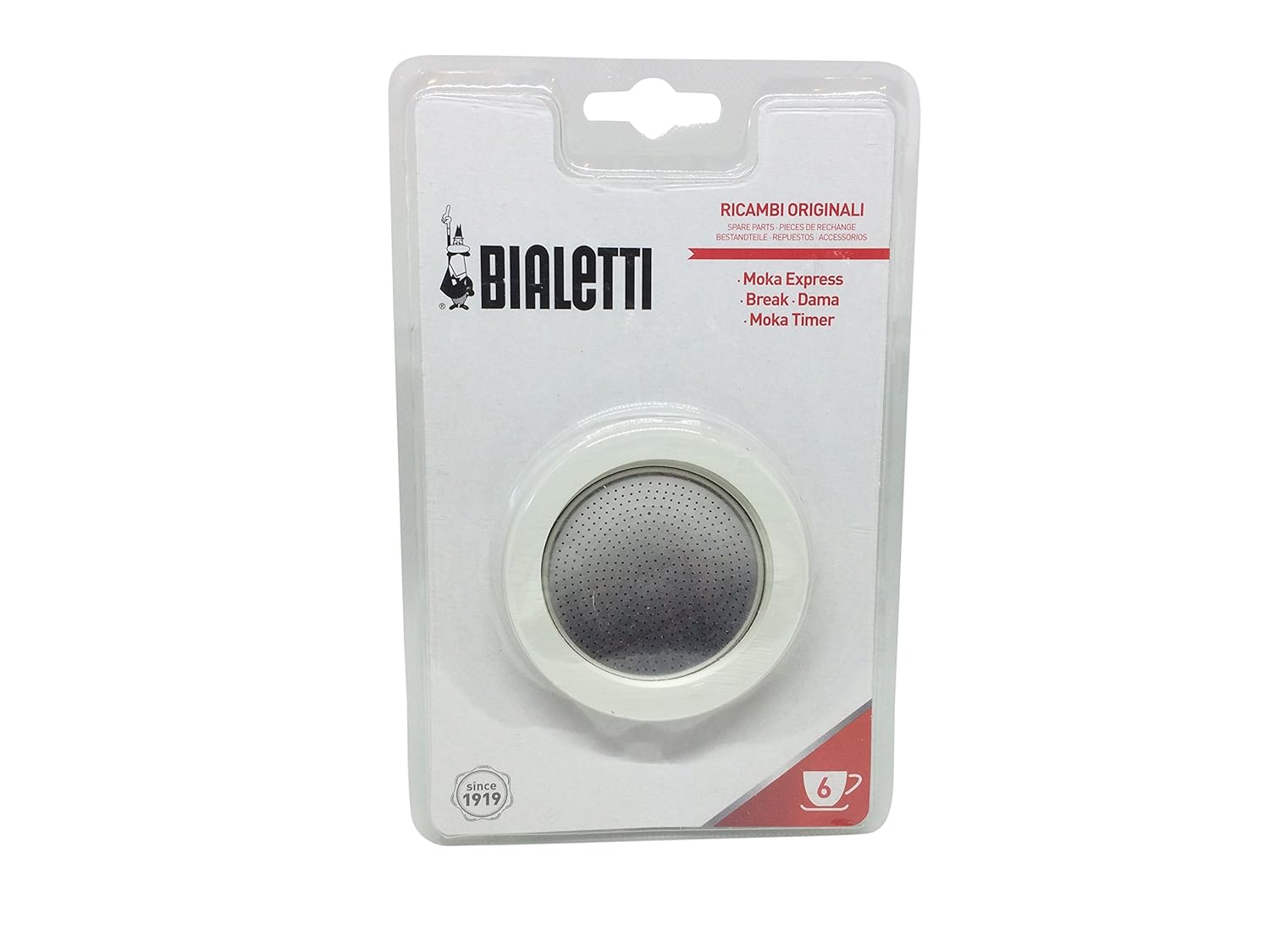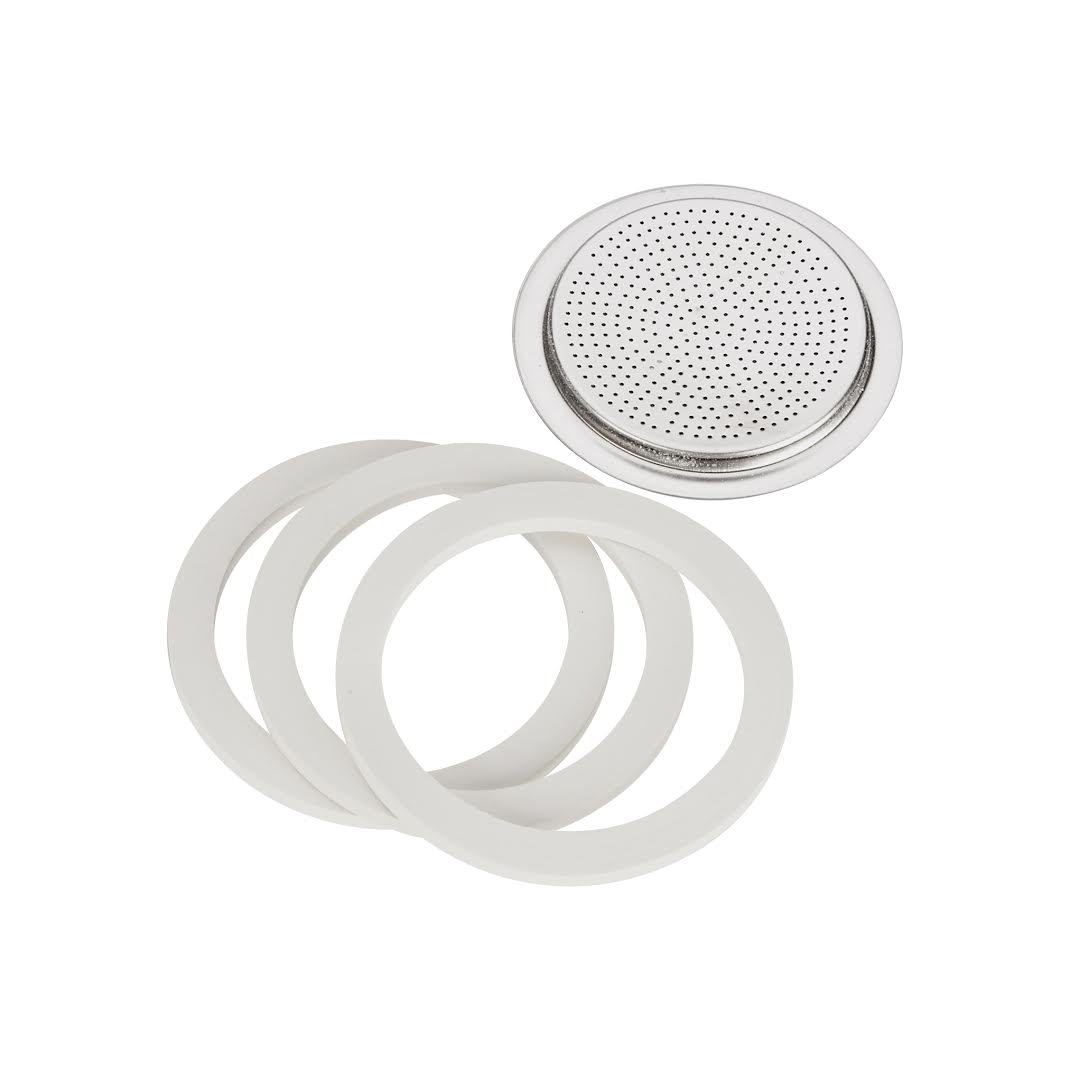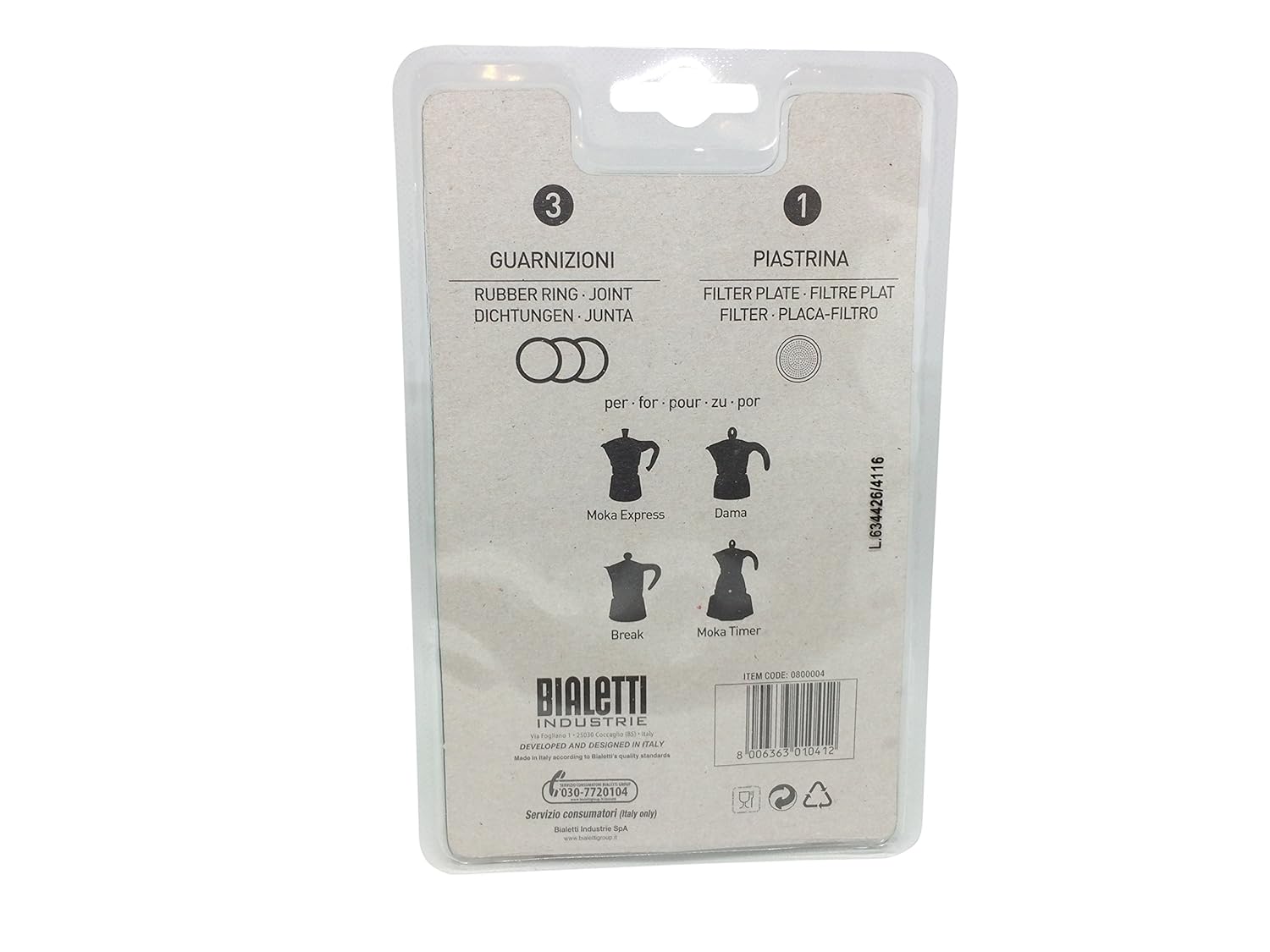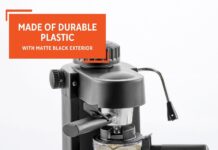Would this simple, small replacement kit really keep my Moka Express brewing like new?
First impressions
I was immediately pleased that the product name was so specific: Bialetti Moka Express 6 Cup Replacement Filter and 3 Gaskets , White. I like replacement parts that tell you exactly which model they fit, and this one does. Right away I felt confident I wasn’t buying a generic part that might not seal or match my pot.
When I unboxed the kit, the parts felt lightweight but solid in my hand. The white filter caught my eye because it’s not the typical metallic finish, and the three rubber gaskets looked properly formed. The overall presentation gave me the sense that I was getting authentic Bialetti parts rather than a low-cost knockoff.
Product overview
I read the product details carefully: it Fits the 6-Cup Moka Express Includes 3 gaskets and 1 filter Outside Diameter 2 7/8″ Authentic Bialetti Parts Satisfaction Guarantee. Those points matter to me because they address fit, completeness, and authenticity. I appreciate that the listing included the outside diameter (2 7/8″), which helped me confirm compatibility with my 6-cup Moka.
This kit is focused and simple: one replacement filter plate and three gaskets. For anyone who uses their Moka Express frequently or who has worn seals, this is a compact maintenance kit that addresses the two most common wear items. I like that Bialetti included multiple gaskets, since gasket wear can be unpredictable and I don’t want to buy a single gasket and then find it fails the next month.
What’s in the box
I want to be explicit about what arrived so you know what to expect. The kit contains:
- 1 white replacement filter plate (outside diameter 2 7/8″)
- 3 rubber gaskets sized for the 6-cup Moka Express
Everything was packaged simply but adequately to prevent rattling and damage in transit. The gaskets were stacked and the filter plate was wrapped separately. Nothing fancy, but also nothing unnecessary.
Compatibility and fit
Because I own a 6-cup Moka Express, fit was a primary concern. The listing clearly states that it fits the 6-Cup Moka Express, and the outside diameter of 2 7/8″ allowed me to measure my existing parts for a match. When I installed the parts, the fit was snug and correct, which is exactly what I want from a replacement component.
If you have a different Moka size, take the measurement of your current filter or gasket before ordering. The 2 7/8″ outside diameter corresponds to the 6-cup unit, and using the wrong size can lead to leaks or poor pressure build-up. I recommend confirming the model of your Moka before buying.
Specifications breakdown
I created a quick table to make the basic specs easy to scan. I find tables helpful when I’m comparing replacements.
| Item | Details |
|---|---|
| Product name | Bialetti Moka Express 6 Cup Replacement Filter and 3 Gaskets , White |
| Fits | 6-Cup Moka Express |
| Includes | 1 filter plate (white), 3 rubber gaskets |
| Outside Diameter | 2 7/8″ |
| Parts authenticity | Authentic Bialetti Parts |
| Guarantee | Satisfaction Guarantee |
| Primary materials | Metal filter plate (white-coated), rubber gaskets |
| Typical use | Replacement parts for worn filter/gasket, maintenance kit |
This table made it easy for me to confirm whether the kit matched my needs, and I think it will be useful for anyone deciding on compatibility and contents.
Installation and setup
Installing the filter and gaskets was straightforward for me, though I took my time to ensure a proper seal. I always prefer careful installation to avoid damaging the new gasket or misaligning the filter. For the Moka Express, the installation process is short but requires attention to detail.
The steps are intuitive, and if you’ve ever replaced a gasket in a coffee maker or similar device, you’ll find this familiar. I like that Bialetti keeps the parts simple and doesn’t require any specialized tools or adhesives to fit them correctly.
Step-by-step installation
I followed these steps when installing the parts, and it worked smoothly:
- Disassemble the Moka Express and empty any used grounds and water.
- Remove the old filter plate from the upper chamber. If it’s stuck, I gently tapped the rim or used a soft tool to pry it loose without scratching the aluminum.
- Take out the old gasket from the lower lip where it sits around the coffee funnel.
- Fit the new gasket into place, making sure it’s seated evenly with no folds or twists.
- Place the new white filter plate on top, aligning the central hole with the funnel spout.
- Reassemble the pot and perform a test brew with just water to check for leaks and proper pressure.
I ran a few test cycles with plain water first, which helped me verify the new gasket had seated correctly and that the filter was aligned. I recommend that as a precaution; it avoids wasting coffee if there’s an issue.
Tools needed
I didn’t need any special tools beyond common household items. You might find these helpful:
- Soft cloth or towel (to protect finish)
- Soft plastic or wooden tool (to nudge stuck parts)
- Warm water for pre-soak (if old parts are corroded)
I avoided metal prying tools to prevent scratching the aluminum of the Moka Express. A soft plastic spudger or butter knife wrapped in a cloth works well if you need extra leverage.
Performance
After installation, I focused on how the pot brewed with the new filter and gaskets. Performance for me is measured in extraction speed, pressure consistency, and absence of leaks. The Moka Express depends on a good seal and unobstructed filter to push hot water through coffee grounds and produce the familiar strong brew.
I noticed the pot reached the sputtering stop point in a typical timeframe for my stovetop and the flow was steady. There were no odd spurts or excessive foaming, and the brew arrived with a full, rounded aroma. From a brewing standpoint, the kit did exactly what it needed to do.
Brewing performance
The flow rate was consistent with what I expect from my Moka Express. The new filter had small, even perforations and the gaskets provided a solid seal so the pressure built up normally. I timed a few brews and the duration matched previous brews with a fresh gasket, which reassured me that the parts were sized and functioning properly.
I felt the extraction was balanced—no watery underextracted cups and no bitter overextraction. The recipe I typically use (finely ground, even tamp-free bed, medium heat) produced a concentrated coffee with proper body and richness.
Taste and aroma
Taste is subjective, but personally I noticed no adverse flavors from the replacement filter or gaskets. Sometimes cheap aftermarket parts can impart a rubbery or metallic aroma, particularly when new, but with a couple rinses and a water-only brew, any minor manufacturing residue dissipated. The coffee kept its bright top notes and a smooth mid-palate that I enjoy.
I think the quality of your grounds and grind size matter far more to the final flavor than small differences in replacement parts, but poor seals or clogged filters can definitely harm extraction. With these parts in place, my coffee tasted right.
Build quality and materials
I examined the materials closely. The filter plate is metal with a white finish, and the gaskets are made of resilient rubber. Both felt appropriate for repeated heat and pressure cycles. The white coating on the filter plate looked uniform and durable, although it’s not a high-precision aesthetic detail I care much about beyond basic finish quality.
The gaskets are flexible yet firm enough to hold a seal. They have the proper thickness to compress into the groove when the top and bottom chambers are tightened together. I like that Bialetti supplies extra gaskets—having replacements on hand is convenient.
Filter design
The filter is a single plate with stacked holes and a central spout hole to fit over the coffee funnel. The white finish is likely painted or coated aluminum, which should resist corrosion in a normal usage timeline. The hole pattern is comparable to original Bialetti filters I’ve seen, so flow distribution is even.
When I inspected it after a few uses, the filter remained intact with no warping or discoloration. I still recommend hand drying the filter and storing it roomy, because oven or dishwasher heat cycles could eventually impact the coating.
Gaskets quality
The three rubber gaskets were manufactured cleanly with smooth edges and a consistent profile. They compress properly without folding if you seat them carefully. I ran the pot through several brewing cycles and watched for micro-leaks or smell of rubber; after initial rinses I didn’t detect anything unusual.
Gaskets are inherently wear items, especially if you use rough cleaning tools or abrasive detergents. I appreciated having spare gaskets in the kit because they give me peace of mind that I can swap in a fresh seal when needed without waiting for a replacement shipment.
Cleaning and maintenance
I follow quick cleaning rituals with my Moka Express, and these replacement parts didn’t complicate that routine. The filter and gaskets were easy to clean by hand, and I found that gentle detergents and warm water are sufficient. I avoid dishwashers for the gasket ring and the white-coated plate to preserve material longevity.
My cleaning routine is short: cool, rinse, and dry. I also periodically remove and inspect the filter and gasket to ensure nothing is trapped under the filter plate. Preventative maintenance is what keeps the Moka brewing consistently.
How I clean it
Here’s the method I used and found effective:
- After brewing, I let the Moka cool slightly, then I empty grounds and rinse both chambers with warm water.
- I remove the filter plate and gasket and rinse those components separately, paying attention to the gasket groove and filter holes.
- I use a soft brush or cloth to remove residue; I avoid metal brushes or abrasive pads.
- I dry all parts thoroughly before reassembling to avoid trapped moisture and potential oxidation in the aluminum.
This kept everything clean and ready for the next brew without damaging the replacement parts.
Longevity tips
I want my parts to last, so I avoid harsh detergents and high dishwasher heat. I recommend:
- Hand washing only, to preserve the gasket elasticity and filter coating
- Avoiding long soaking in acidic cleaners
- Replacing gaskets at the first sign of cracking, flattening, or persistent leaking
- Periodic dry runs to check for leaks after replacing parts
If you store your Moka with the lid off, it helps prevent lingering smells and moisture buildup.
Troubleshooting common issues
Even with authentic parts, you can encounter problems. I found it helpful to anticipate these and try some simple fixes before assuming a part is defective. Many issues are due to installation or leftover debris.
I want to share the troubleshooting steps that worked for me when I encountered minor issues like slight leakage or slower-than-usual extraction. Simple adjustments usually solved these problems.
Leaks and sealing
If you notice leaks around the joint after replacing the gasket, first check that the gasket is seated evenly and not twisted. I found that a misaligned gasket often caused small drips. Tighten the top and bottom chambers by hand to the usual snugness—over-tightening can deform the gasket and under-tightening causes leaks.
If the leak persists, inspect the gasket for damage or the sealing surfaces for dents or coffee grounds trapped in grooves. Sometimes small crumbs prevent a perfect seal. A quick clean and reseat solved the majority of the leaks I encountered.
Flow problems and slow extraction
Occasionally the brew might flow slower than expected or sputter. I checked the holes in the filter plate for blockage and cleaned them with a soft brush. Also, ensure your grind isn’t excessively fine — a Moka needs a grind coarser than espresso. If the filter plate isn’t aligned perfectly over the funnel, the flow can be uneven; adjusting alignment fixed this for me.
If flow remains restricted after cleaning and alignment, check the safety valve in the boiler for blockage (only clean when the pot is thoroughly cool), and ensure there’s not a vacuum lock caused by assembling while parts are hot.
Comparison with alternatives
I compared this authentic Bialetti kit to generic aftermarket replacements I’d used before. The authentic parts generally matched my original parts more closely in fit and feel. Some aftermarket gaskets had slightly different thickness or diameter, which led to small sealing issues.
Cost differences exist: aftermarket kits can be cheaper, but I found the peace of mind with authentic parts worth the occasional premium. The white filter here was also closer in finish and hole pattern to my original than some cheap copies I tried in the past.
Aftermarket vs authentic Bialetti
My experience shows pros and cons of both:
- Authentic Bialetti: better fit, predictable quality, potentially longer lasting, pricier
- Aftermarket: lower price, variable fit and quality, sometimes cheaper materials
Because the Moka functions based on pressure and seal, I personally prefer authentic parts for reliability. I found that buying the genuine kit reduced the frequency of minor issues that required trial-and-error fixes.
Other sizes and models
If you have a 3-cup or 9-cup Moka Express, look specifically for replacement parts sized for those models. The 2 7/8″ outside diameter in this kit is tailored to the 6-cup. I own different sizes in the past and it became clear to me that using the correct parts for each size avoids leaks and uneven flow.
Bialetti makes a range of replacement kits for other models, and their parts are usually well labelled. Measure if you’re unsure, and match the diameter specifications when ordering.
Value for money
I considered the price against the convenience of having three gaskets and one properly sized filter. Because the gaskets are common wear items and the filter contributes to even extraction, I think this kit represents fair value. Buying kits proactively can save me time and money versus emergency replacements.
I also value the satisfaction guarantee, which gives me confidence in the purchase. If a part doesn’t fit or is defective, I know there’s a route to resolution. That peace of mind factors into my assessment of value.
Cost of replacements
When I looked at how often I’d need to replace gaskets and possibly a filter, the triple-gasket pack made financial sense. Individually purchasing single gaskets over time tends to add up. I also appreciate having spares on hand so I don’t have to stop brewing if a gasket goes bad.
Factor in the longevity of the filter and gaskets with proper care—these parts don’t need frequent replacement unless used heavily or abused. For typical household use, I expect a set to last a long time.
Is it worth buying
For me, the answer is yes. If you own a 6-cup Moka Express and take your coffee seriously enough to maintain equipment, this kit is an inexpensive and effective maintenance investment. It keeps your pot working as intended and avoids leaks or compromised extraction that would detract from the coffee experience.
If you’re casual about brewing or rarely use your Moka, a single gasket might suffice, but I still recommend genuine parts for fit and reliability.
Warranty and guarantee
The product description includes “Authentic Bialetti Parts Satisfaction Guarantee.” I tested the guarantee in spirit by inspecting the parts upon arrival and running test brews. Fortunately, everything worked so I didn’t need to make a claim, but knowing the guarantee exists made me comfortable ordering.
If ever needed, Bialetti’s customer support or the seller’s return policy would be my first stop. Save the original packaging and proof of purchase in case you need to initiate a return or exchange.
Satisfaction Guarantee details
While the listing states a satisfaction guarantee, specific terms vary by seller and region. Typically, that means defective or mismatched parts can be replaced or refunded within a certain window. I recommend checking the seller’s return policy and Bialetti’s official guidance where you buy the kit, because that will clarify time limits and conditions.
If you value a no-hassle replacement experience, purchase from a reputable retailer that clearly states their return and refund timelines.
How to claim
If a part arrives damaged or doesn’t fit:
- Take photos of the part and the package.
- Contact the seller or Bialetti support with order info and images.
- Follow their instructions for return shipping or replacement.
I keep my receipts and order confirmations organized so I can act quickly if a claim becomes necessary. That made the process smoother the couple times I had to return small items in the past.
Pros and cons
I find it helpful to list strengths and weaknesses so I can evaluate purchases at a glance. These reflect my experience with Bialetti’s 6-cup kit.
Pros:
- Genuine Bialetti parts that fit the 6-cup Moka Express
- Includes three gaskets, giving me spares
- Filter matches original hole pattern and size (2 7/8″ OD)
- Simple to install and maintain
- Satisfaction guarantee for buyer confidence
Cons:
- White-coated filter may be more cosmetic than functional; some users might prefer bare metal
- A bit pricier than generic aftermarket options
- Not dishwasher-safe per my cleaning recommendations (hand washing preferred)
These pros and cons balanced out in my decision to keep and recommend the kit for owners of the corresponding Moka model.
FAQs
I often have the same questions when buying replacement parts, so I compiled answers that helped me and might help you too.
Q: Will these parts fit a 6-cup Moka Express from any production year? A: Generally yes, as long as it’s a standard 6-cup Moka Express with compatible dimensions. The outside diameter of 2 7/8″ is the primary identifier. However, older vintage models or special editions may have slight dimensional differences—measure if unsure.
Q: Are the gaskets food-safe? A: The gaskets are made for coffee makers and are intended to be food-safe under normal use. If you are concerned about materials, check the product listing for material specifics or contact the seller for confirmation.
Q: Can I use the filter and gaskets in a stove-top Moka other than Bialetti? A: Compatibility depends on dimensions. If the other pot’s dimensions match (2 7/8″ OD for the filter and matching gasket groove), it may fit. I recommend confirming measurements first.
Q: Do I need to run the filter and gasket through multiple water-only cycles before using coffee? A: I recommend rinsing and doing at least one water-only test run to remove any manufacturing residue and verify the seal. That’s what I did and it avoided any off-flavors or surprises.
Q: How often should I replace the gasket? A: It depends on frequency of use. For daily use, you might replace the gasket every 6–12 months. I watch for cracking, hardening, or small leaks and replace as needed. Having three included in this kit gives me a buffer.
Q: Is the white filter plate likely to chip or discolor over time? A: Coatings can show wear with heavy use or aggressive cleaning. I recommend gentle care and hand washing to maintain the finish. Functionally, even if the coating shows wear, the filter should still work as long as the metal underneath isn’t damaged.
Troubleshooting checklist
When something goes wrong, I go through a quick checklist to isolate the issue. This saved me time and avoided unnecessary part returns.
- Check gasket seating and alignment
- Inspect filter holes for blockage
- Ensure grind size is appropriate for Moka (not espresso fine)
- Verify safety valve is clean and free-moving
- Perform a water-only test brew to look for leaks
- Avoid over-tightening or under-tightening the unit
These steps fixed most of the minor problems I personally encountered and they’re simple enough to follow before contacting support.
Final thoughts and recommendation
After using the Bialetti Moka Express 6 Cup Replacement Filter and 3 Gaskets , White for several brews, I feel confident recommending it for owners of the 6-cup Moka Express. The parts fit well, performed reliably, and required only routine cleaning and maintenance. I especially value the inclusion of three gaskets, which makes future upkeep easier.
If you rely on your Moka for daily coffee and want consistent performance, choose authentic parts like this to maintain pressure and avoid leaks. If you’re on a tight budget and willing to risk variable fit, aftermarket options exist, but I found the genuine kit worth the slightly higher price for dependable results.
I plan to keep one gasket in reserve and rotate them as needed, and I’ll continue to treat the filter plate gently during cleaning. For me, this kit extends the life and performance of my Moka Express and keeps those morning cups tasting just right.
Disclosure: As an Amazon Associate, I earn from qualifying purchases.


